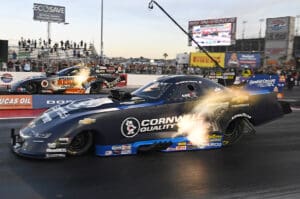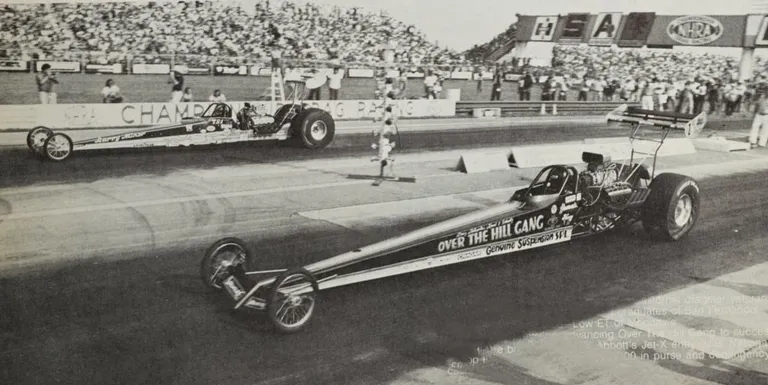 Five years ago, the IHRA Pro Stock division relied on two major engine
Five years ago, the IHRA Pro Stock division relied on two major engine
builders to service as many as twenty to thirty Pro Stock teams. If you
ran a Ford, you had Jon Kaase horsepower. A Chevrolet or GM meant you
relied on Sonny Leonard for your engines.
Today’s IHRA Pro Stock division stands prepared to reach for the next level with in-house engine programs.
As many as four prominent teams have embarked on exclusive engine
programs. The IHRA’s Pro Stock division has always been considered a
less expensive alternative to the highly-complex 500-inch NHRA
programs.
Pete Berner, 2006 IHRA Pro Stock world champion, became the latest to
announce such a program. He will partner with former Pro Stock racer
Jerry Janota.

Five years ago, the IHRA Pro Stock division relied on two major engine
builders to service as many as twenty to thirty Pro Stock teams. If you
ran a Ford, you had Jon Kaase horsepower. A Chevrolet or GM meant you
relied on Sonny Leonard for your engines.
Today’s IHRA Pro Stock division stands prepared to reach for the next level with in-house engine programs.
As many as four prominent teams have embarked on exclusive engine
programs. The IHRA’s Pro Stock division has always been considered a
less expensive alternative to the highly-complex 500-inch NHRA
programs.
Pete Berner, 2006 IHRA Pro Stock world champion, became the latest to
announce such a program. He will partner with former Pro Stock racer
Jerry Janota.
Berner joined 2007 champion Robert Patrick, Robert Mansfield and Elijah
Morton, all who branched out of their own since 2004. At least two of
the four have NASCAR connections.
Each team, when queried why they went this route, agreed a desire to
keep research and development secrets as a major factor. They all had
other reasons to add.
“You want to be able to control your own destiny and when you get your
own program going you certainly have got it and you keep it so
therefore once you get ahead, you stay ahead,” Morton said.
I think we’re in a better situation than with the guys with the
in-house programs. Sonny and Kaase both have a lot
of customers each, but they can try things on different cars, they can
try one camshaft in my car, another in someone else’s car and come to
some type of conclusion of what works best in their applications. To me
if they’ve got 7 or 8 customers each they are at an advantage over the
guys that only have the one customer. – IHRA Pro Stock point leader John Montecalvo

For Berner, the decision to step up with the engine program didn’t
necessarily mean he wanted to dominate the IHRA mountain motor market.
He’s using the experience to eventually test the waters of the 500-inch
market.
”We’re not going to go any farther if we can’t compete with the
Mountain Motors because there’s just a lot more technology involved
with the 500-inch guys,” Berner admitted. “They live, breathe and do
everything they can to make horsepower in 500 inch racing. You
basically have to have that same discipline. We’re going to see if we
can retain that discipline.”
Patrick’s insatiable desire to distance himself from the rest of the
front-runners started with a desire to join up with Ingles on his
program prior to the 2005 season.

“The way I felt about it was when you had two engine builders that had
85% of the field they could kind of control what was going on because
as long as one of them didn’t get too quick they kept everybody running
the same then they didn’t have to do a lot of work,” Patrick said. “I
know they were trying to make their stuff better but they were happy
but it looked to me when I was involved was in finding one or two
little updates and then giving that to everybody for the next year and
that’s it. Then once the season started basically they didn’t try to
find power, because they had so many customers they were just busy
trying to keep everybody’s motors running.
Mansfield’s program began in 2004 when he left Sonny Leonard to join
forces with Ron Hutter, a known figure in NASCAR engine technology.

Not every IHRA Pro Stock racer believes having an in-house program is
the best route to travel. Current points leader John Montecalvo has
been a longtime customer of Leonard’s and he’s content to remain that
way for a long time.
“I think we’re in a better situation than with the guys with the
in-house programs,” Montecalvo said. “Sonny and Kaase both have a lot
of customers each, but they can try things on different cars, they can
try one camshaft in my car, another in someone else’s car and come to
some type of conclusion of what works best in their applications. To me
if they’ve got 7 or 8 customers each they are at an advantage over the
guys that only have the one customer.”
Montecalvo believes such a move does nothing more than increase the price on competing in the class.
“It means taking your dollars to the next level,” Montecalvo added. “It
would definitely cost a lot more money, at least now the r&d with
the Sonny’s people and Kaase’s people the data is shared among 5,6,7,
or 8 customers. I think that we have an advantage that way, I think it
cost us less money and I think we get better results.”
One of the positive byproducts, Morton adds, is the opportunity to recoup some expense through engine lease programs.
“There’s so much money invested in building your own engine program and
when you consider there’s people calling everyday wanting to lease an
engine, that day is coming,” Morton said. “We’re not quite to the point
where we want to do that yet. Once it does get to the point like the
NHRA Pro Stock lease engines get to, there’s big dollars there just to
lease your engines. It saves the racers from spending the money to
develop their own, and they get to ride fast and enjoy it.”
Morton said the lease engines could be one year away from coming out.

THE COST OF RACING IHRA PRO STOCK – Patrick left the IHRA’s mountain motor format to run in the NHRA’s 500-inch

The
next two races for Robert Patrick will determine if he attends the
event in Edmonton. His assessment is the Pro Stock purses have not
increased at the level the costs of maintaining the cars have.
program
in 1995. The defending world champion eventually returned in 2003 after
the spiraling costs of remaining competitive didn’t jibe with his
financial bottom line.
He says the cost is getting comparable in today’s IHRA Pro Stock division.
“We’re spending about the same right now to race as we were back in the
late 1990’s in NHRA,” said Patrick. “I think you’re going to see all
that come to a head with the way the economy is going, the diesel fuel
price and the fact the purses aren’t going up. The costs of racing the
motors are 50% more than they were 10 years ago. The tires costs more,
clutches costs more, transmissions are a third more than when I started
racing. The purses really haven’t gone up, so there comes a point when
you got to say hey you know this is a business and if you can’t make a
profit at it, you know you’re going to have to fold your tent down and
go home.”
Patrick is just one of a handful of IHRA Pro Stock teams who have
invested in an in-house engine program. His program is headed up by
championship assembler Bob Ingles.
“This could all change if the IHRA ups the purses,” Patrick said. “I
think you could see Pro Stock reached that next level but who’s going
to go out there and invest another half-million dollars in an engine
program when the purses are staying the same. That just doesn’t make
good business sense.”
With the complexity of today’s U.S. economy and the spiraling costs of
diesel fuel, Patrick and other teams are carefully plotting the balance
of their travel schedule.
“Right now looking at the next two races honestly to see where I’m at
in the points and if I’m not up where I need to be, I’m not going to go
to Edmonton. I can run a Ford race an hour and a half from the house
that pays the same money. I’d love to go to Edmonton and support IHRA
and if I’m in the points I will, but basically if you don’t go to the
final out there you’re not going to break even for the trip.
“You’re looking to spend $5000.00 in fuel to go out there and the
national average of diesel fuel is $5.66 a gallon, it’s hard to justify
driving 50 hours and airline tickets, food and everything else and
you’re going to walk away with a measly few grand for qualifying.”






































